The OEM tires on your Toyota Tacoma are adequate for most purposes, but they aren’t the best at one thing.
Tire varieties are nearly endless, and finding something that works for you is going to require a fair bit of research, trial, and error.
So whether you want a set of tires that work well on tarmac as well as gravel, or if you want something to complement your lift kit without any rubbing, you’re going to want to know what tire size is right for you.

This guide will walk you through everything you need to know about the tires on your Toyota Tacoma. We’ll cover OEM sizes, tire specs for leveling kits, maximum upsizing options, and more.
Stock Toyota Tacoma Tire Sizes
Choosing the right tires for your Tacoma starts with knowing what tire sizes these trucks usually come with. The chart below outlines the OEM-recommended sizes to help you narrow down your options.
But keep in mind that tire sizes for each generation of the Tacoma come down to its trim level and the specific package that it came with originally, so it will vary a bit from truck to truck.
| 1995 – 2000 | 2001 – 2004 | 2005 – 2015 | 2016 – 2022 |
| 195/75R14 | 205/75R15 | 215/70R15 | 245/75R16 |
| 205/75R14 | 235/55R16 | 245/75R16 | 265/70R16 |
| 215/70R14 | 225/75R15 | 265/70R16 | 265/65R17 |
| 225/75R15 | 265/70R16 | 265/65R17 | 265/60R18 |
| 31X10.5R15 | 255/45R18 | ||
| 265/75R15 | 265/60R18 |

Generally, you can get away with increasing your tire’s height and width by 3% with the need to install a Tacoma leveling kit. This will give you an extra 1” in height and 3” in width. Tire dealers call this a “plus 1” tire size increase.
Another thing to remember is that if you do install a leveling or lift kit on your Tacoma, you can add 1” in tire height for every 1” of lift.
This doesn’t apply to tire width though. Installing wider tires has to do with choosing wider rims with the right amount of backspacing and offset.
For example, installing taller tires will require you to raise your truck with either a leveling or lift kit. However, installing wider tires will require you to choose the right rim offset to avoid rubbing issues.
Reading Tire Specifications
When reading tire sizes, there are four main things you should look at. With Tacomas, the first part is easy.
Every Tacoma only needs passenger-rated tires (P), although if you plan on doing a lot of off-roading, you can upgrade to a set of light-truck-rated tires (LT).

These letters appear right before the tire size. Both options will work for your truck, you’ll just pay more for a higher-rated tire.
The first and only three-digit number you see is the tire width in millimeters. This number only tells you how wide the tire is.
The two-digit number directly after the “/” is the aspect ratio: section height divided by section width. The “section height” is simply the height of the sidewall, not including the rim.
For instance, if you’re comparing two tires with identical widths but different aspect ratios, the higher the aspect ratio, the taller the tire will be.
The final number is the rim size. This isn’t something you can change without swapping out rims.
If you want to graphically compare two different tire sizes and view interesting data on how fast the two will spin at different speeds, consider using Tacoma World Forum’s tire size calculator.
Largest Tire Size on Stock Tacomas
With the stock sizes and fundamentals out of the way, let’s get into the meat of the matter.
One of the most frequently asked questions in the Taco community is “What’s the biggest tire on a stock Tacoma?” — the answer depends on what wheels you have on.
If you’re running OEM wheels and stock suspension components, no lift kit or leveling kit, then the maximum tire sizes for Gen 1, Gen 2 and Gen 3 Tacomas are as follows.
Gen 1 Tacoma Maximum Tire Size
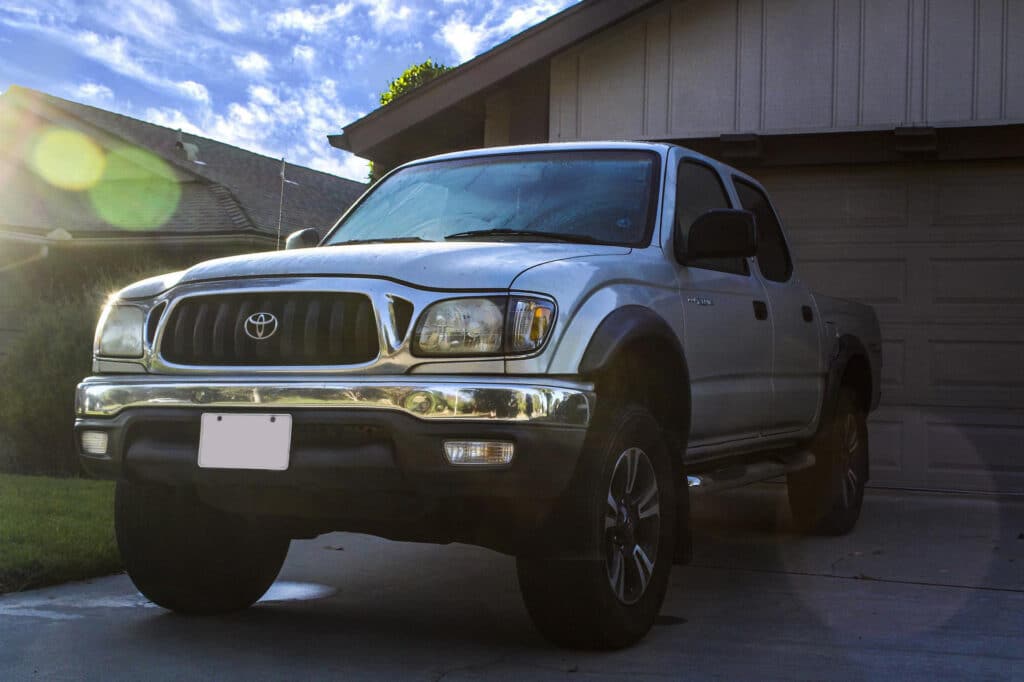
The largest rim size you get on stock Gen 1 Tacomas is 16″, and the largest tire that fits on these rims without clearance issues is 265/75R16. These tires are about an inch taller than the stock 265/70R16s.
You can install 265/75R16 tires on other model years of the Gen 1 Tacoma, but for that, you will also need to install 16” rims.
If your Gen 1 Tacoma is from the model years 1995 to 2000, then the largest OEM rim size for your truck is 15”. The largest tire size, in that case, is 31X10.5R15s, with the closest metric equivalent being 265/75R15.
Compared to the largest 16″ rim option it’s about ⅔ of an inch shorter. However, if you want to properly upsize and install tires larger than 16”, you’ll need to look at aftermarket rims and lift kits.
Maximum Tire Size for Gen 2 and Gen 3 Tacomas
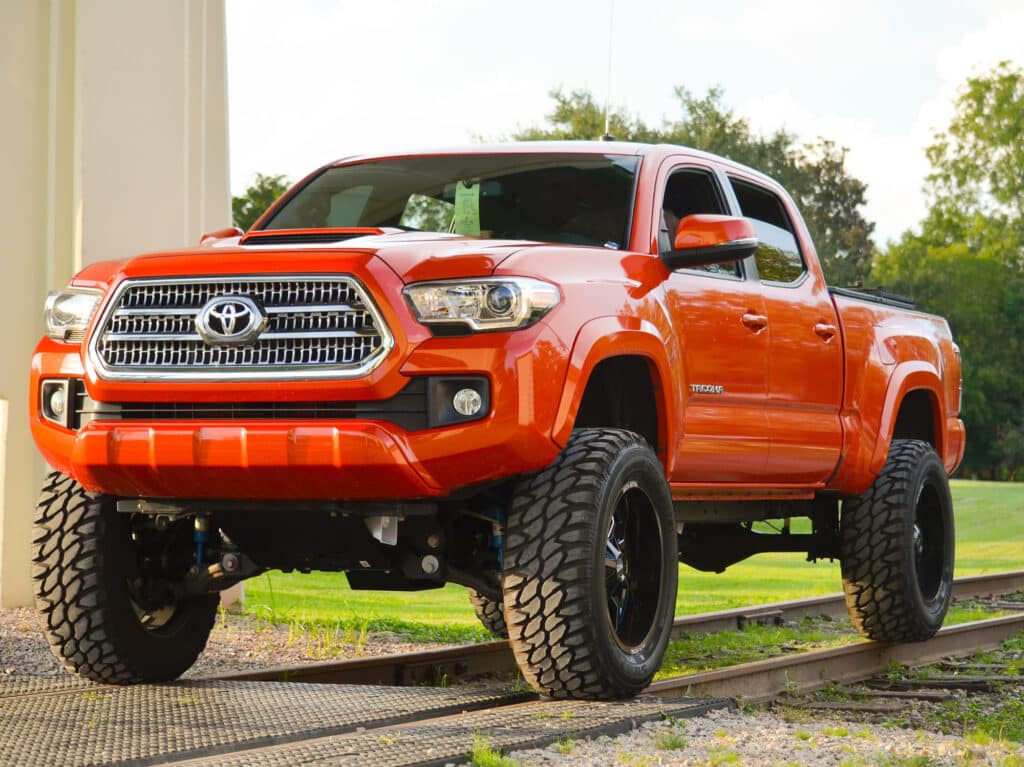
Gen 2 and Gen 3 Tacoma don’t come with 14” OEM rims, which is a good thing if you’re looking for larger tires.
The minimum rim size starts at 15″ and goes all the way up to 18″, which gives you a lot more flexibility when it comes to upsizing. Maximum tire size options (without clearance issues) for OEM 16”, 17”, and 18” rims include:
- 16″: 265/75R16
- 17″: 265/70R17
- 18″: 265/65R18
The same applies to 3rd gen Tacomas because they have the same rim size options and wheel specs as the Gen 2 models.
Keep in mind that this is all without any modifications. If you’re willing to trim and cut a few parts and install new rims, then you can install even larger tires.
Installing Wheel Spacers

If you want your tires to stick out more, consider installing wheel spacers. Even though the ideal thing to do if you want your wheels to stick out is to use negative offset rims.
If you’re unfamiliar with the latter, check out our article that explains the difference between positive and negative wheel offset.
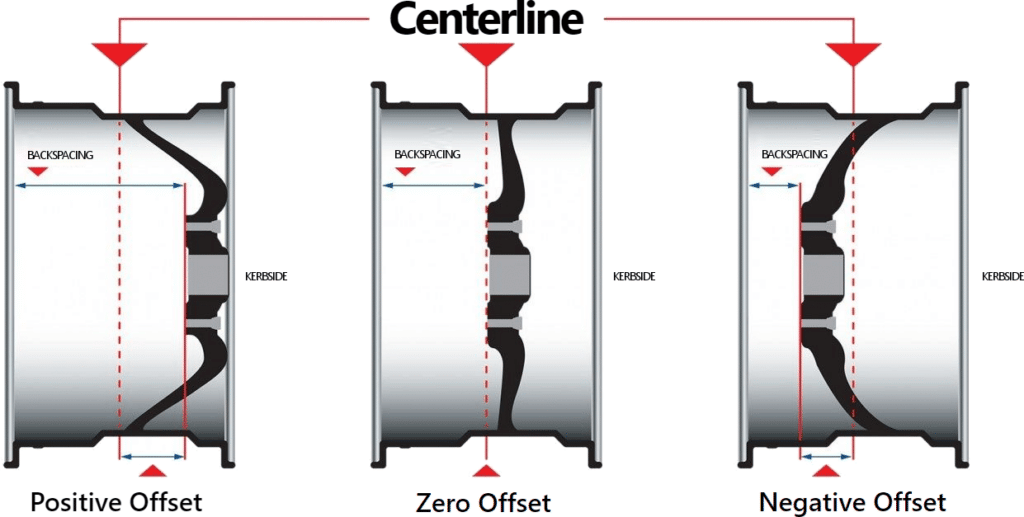
As long as you install wheel spacers correctly, ensure they’re made out of billet aluminum, and understand the risks associated with using them, they’re a viable option.
However, keep in mind using spacers might result in rubbing and clearance issues if you’ve maxed out your tire size. In that case, installing a leveling kit and trimming your bumpers is a solution. You can also pull and roll your fenders if required.
Maximum Tire Size With Levelling Kits
Now that you know the OEM recommended and maximum tire sizes for all 3 generations of the Toyota Tacoma on stock suspension, let’s take a look at how much you can upsize your tires and wheels when you install a leveling kit.
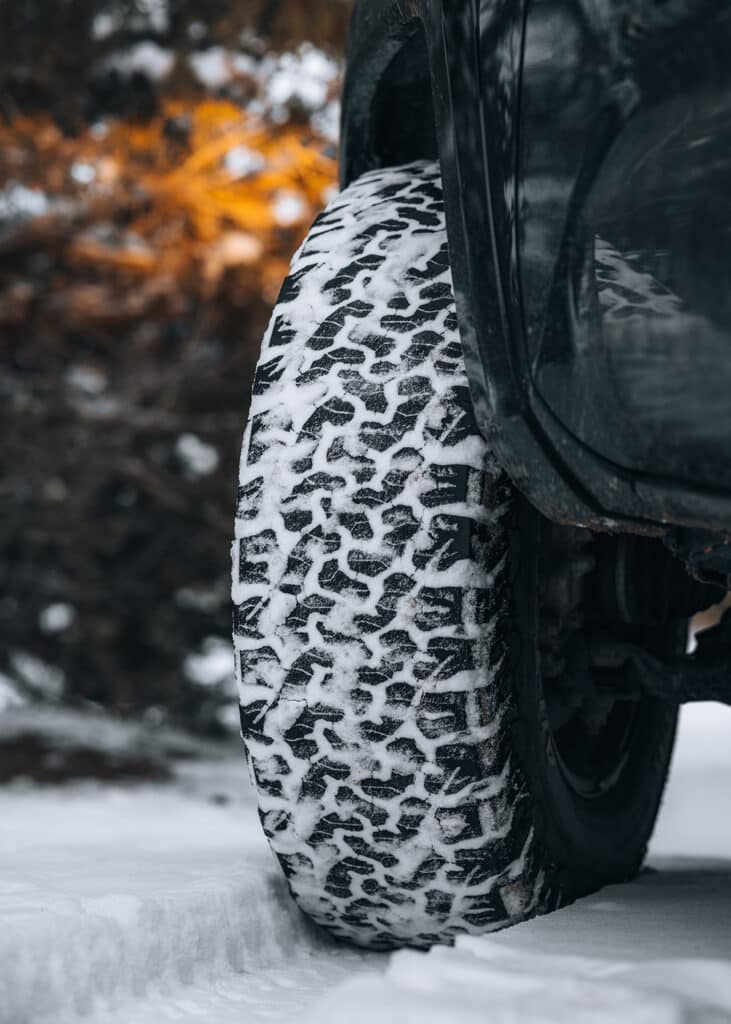
Leveling kits add anywhere between 1” to 3”. In the examples below, we’ll outline the maximum tire size you can use if you have either a 2”, 2.5”, or 3” lift.
But remember, Tacoma wheels come in a plethora of different sizes and offsets. Consider the sizes mentioned below as guidelines.
If you’re unsure about the exact wheel specifications of your Tacoma, you can quickly figure that out if you know how to measure your car’s rim size.
Your exact setup will vary depending on the actual diameter of your tire. These metrics vary from one manufacturer to another, even though they may be labeled with the same sizes.
2″ Lift
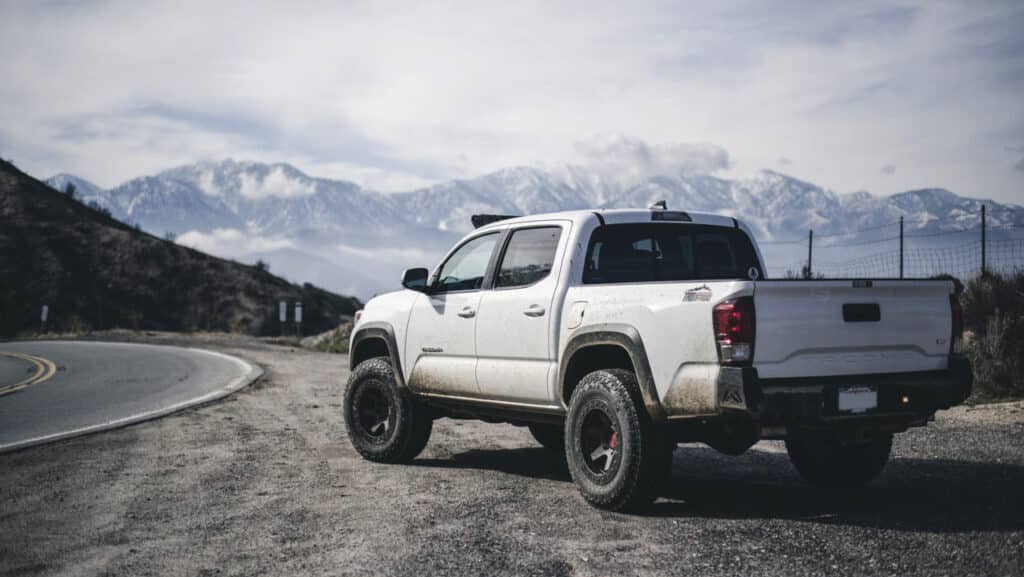
The largest Tacoma tire size with 2-inch lift depends on your rim dimensions. Here’s a list of tire upsizing options categorized according to the same:
- 15”: 265/75/R15
- 16”: 265/75/R16
- 17”: 275/70/R17
- 18”: 275/70/R18
Note that these sizes are suitable for OEM rims (or even aftermarket rims with stock offset), without the need for any cutting or trimming.
On 16” OEM wheels, you can install 265/75/R16 tires without a problem. That’s 1” taller with factory width.
With some cutting and trimming, you can fit 285/75R16 tires with a 2″ lift. You’ll have to cut about 6″ of the inner fender liner, some trimming along the rear bumper as well, and you’ll need to complete a cab mount chop to get them to fit.
If you have 15” stock wheels on your truck, there aren’t many good tire options. We recommend upgrading to 16” or 17” rims.
17” and 18” wheels can take 275/70R17s and 275/70R18s respectively which will make your ride height 1.5” taller and tires 0.4” wider than factory specs.
You could push it and go up to 285/70R17 but at that point, your tires will be too close to the upper control arms.
3″ Lift
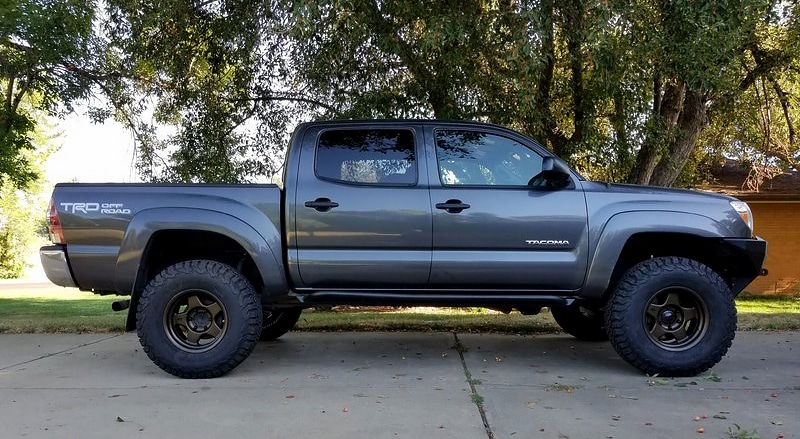
3” is about as high as you can go with a leveling kit; any more than 3” and you’re going to need a lift kit. Recommended maximum tire sizes for 3” lift on OEM wheels include:
- 16”: 285/75/R16
- 17”: 285/70/R17
- 18”: 275/70/R18
That’s about as large as you can go on OEM or stock-equivalent wheels on a 3” lift without any major problems.
285/75/R16 and 285/70/R17 tires are extremely popular on 3rd gen Tacomas because 285 mm width seems to be at a sweet spot.
They’re adequately large, but not large enough to cause any significant clearance issues, and don’t require you to change the gearing of your truck or intrusive fabrication work like getting a cab mount chop.
Although, at full lock, 285s are known to rub against the upper control arms, which comes down to offset and backspacing. This issue doesn’t arise with wheels that have 0 offset and 4.5” of backspacing.
What Is a Cab Mount Chop?

If you’ve done your fair share of research on what modifications you’ll need to make to get different-sized tires to fit on your Tacoma, one thing you’ve probably come across is cab mount chop or CMC.
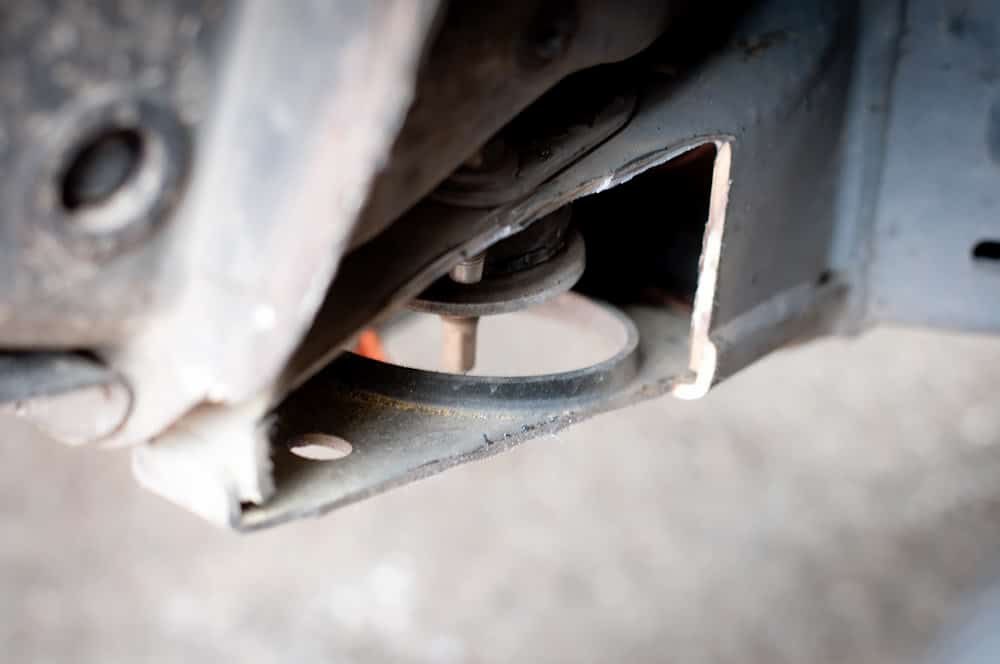
It’s one of the more drastic alterations that involves cutting out the protective plates around the cab mounts and welding new ones in their place.
The whole point of this exercise is that the new plates will sit farther back because they’re flatter, and doing that will open up some extra space for your wider tires.

If you have the experience and all the tools it’s certainly something you can do by yourself, but if you don’t know how to weld or don’t have the equipment, you can always get it done by a professional.
Recommended Leveling Kits
Leveling kits open up a whole new tire size range for all generations of the Toyota Tacoma, even though it requires minor modifications.
Our favorite setup is the 2.5″ front and 1″ rear. Other popular options include a 2″ front and a 1″ rear, a 3″ front and 2″ rear, and a 2″ front and 2″ rear.
We highly recommend the Street Dirt Track (SDT) leveling kit for Gen 2 and Gen 3 Tacomas. It comes with everything you need, including installation instructions, and you don’t need anything past basic hand tools to install it.
However, keep in mind that this kit does not work with 5-lug models. If you do need a setup for a 5-lug Tacoma, consider the ReadyLift setup.
What if You Want Even Bigger Tires?

The tire size options for your Tacoma certainly don’t end at 285/75 or approximately 33”. You can get much larger tires, but that’s only possible with aftermarket suspension and lift kits.
For something like a 35” tire, you’ll need a very aggressive cab mount chop, zero clearance fender flairs, and adjustable suspension so you can alter your ground clearance and ride height.
Another non-negotiable requirement to fit a tire that large is regearing your truck. The 3.5 L V6 can only do so much. Fuel economy will also take a massive hit, and lastly, your spare tire won’t fit on the back of your truck the way it is supposed to.
You’re also going to need a solution to raise your truck. Lift kits are the better option in contrast to leveling kits in this situation.
If budget isn’t an issue, a lift kit is the way to go if you want tires larger than 33”.
Lift kits allow you to raise your truck as much as you need to get the necessary clearance to upgrade the tires. They also typically come with bulked-up suspension components to handle larger tires.
The tradeoff is that they’re more expensive, and it’s not easily reversible. You’re essentially swapping out your vehicle’s suspension, and that’s no small task. But they will allow you to upgrade the tires without any rubbing, cutting, or trimming.
Things to Know Before Upsizing Your Tires

As you must have guessed by now, installing new tires and choosing the right size for the Tacoma isn’t very straightforward.
With most machines, changing one little thing often creates to a ripple effect and impacts 10 other places. Something similar happens when you change your wheel and tire size.
Below we’ve listed four things you need to be aware of before you change out your Tacoma’s stock tires.
Gear Ratios
Toyota specifically engineers the gear ratio in your Tacoma to suit the OEM recommended tire sizes. That means if you’re switching out the tires, you’re effectively using a different gear ratio when you’re driving.
This can lead to a drop in initial acceleration, which is a pretty big deal depending on what you use your truck for. The only way to fix this is to regear your Tacoma by modifying the front and rear differential gear ratios.

The factory gearing on the Tacoma is quite long and doesn’t do well with large-diameter tires. For example, if you’re going from 30″ to 35″ tires, your truck will feel more sluggish off the line.
You’ll feel this when driving off-road. The recommended gearing range for 35″ tires is 4.10 to 4.86.
Speedometer Recalibration
Different tire sizes rotate at different speeds. For instance, a 33” tire will cover a shorter distance in one rotation than a 35” inch tire.
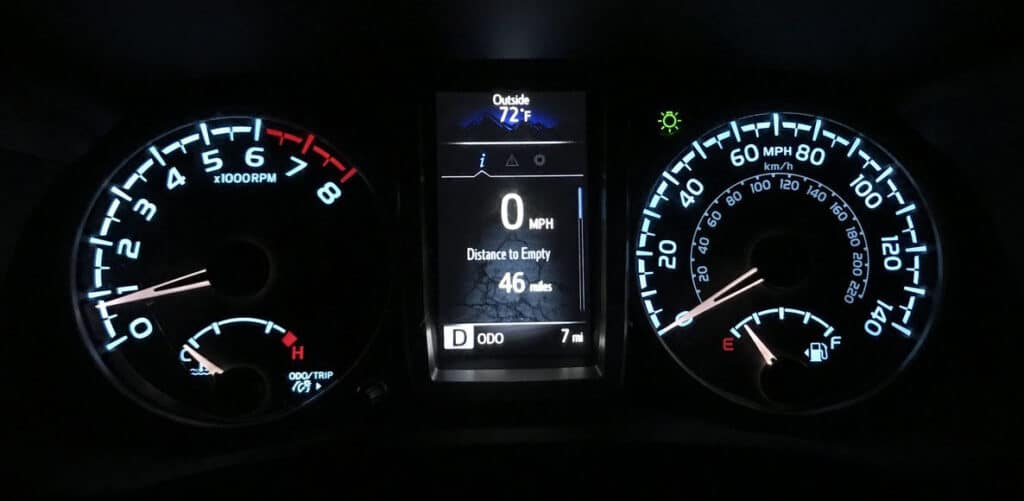
The Tacoma uses wheel speed sensors to communicate with the ECM, and that’s how it calculates the speed. When the wheels are oversized, it changes what your speedometer reads.
In other words, changing the stock wheel size without calibrating your speedometer will make it display incorrect information.
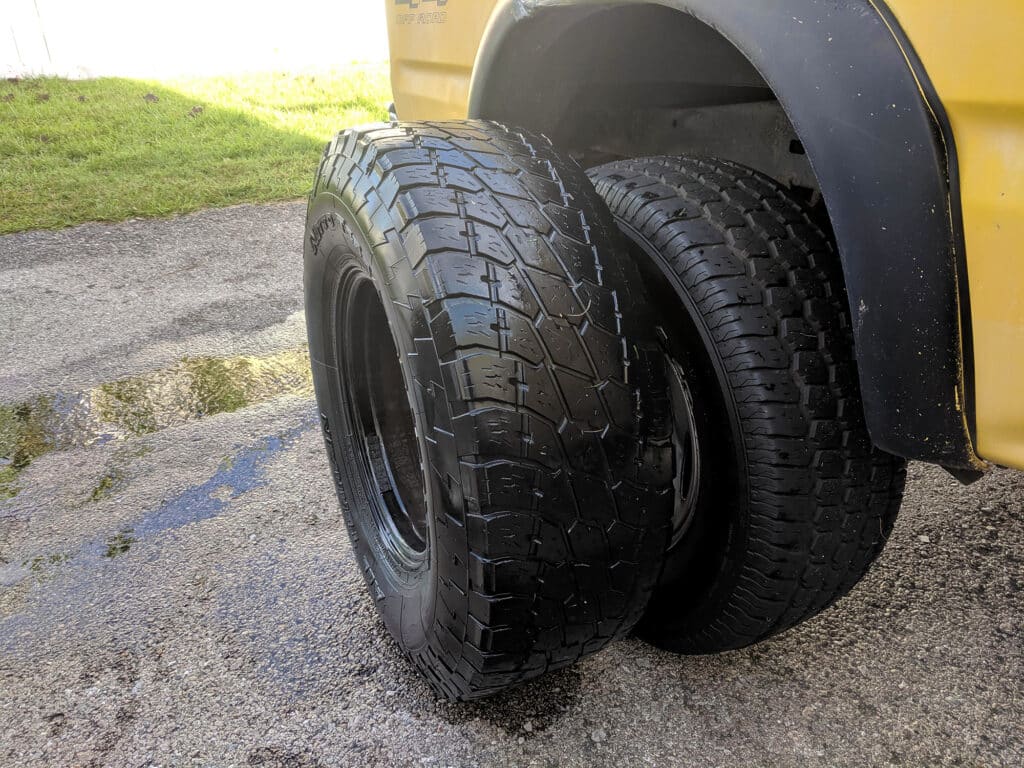
For instance, if you go from a 215/70R15 to a 265/65R18 when your speedometer reads 50 mph you’ll be traveling closer to 59 mph.
If you don’t realize it, that’s enough of a difference to get a speeding ticket when you think you’re going the speed limit.
Warranty
If you read the Tacoma’s warranty information, you’ll realize that as soon as you start installing leveling kits or even changing from the stock tire size, you’re voiding the warranty.
Toyota designs everything to run a certain way, and they’re not taking the risk if you change things out and do it wrong.
Don’t forget to let your Tacoma insurance provider know about the modifications you’ve made to avoid complications.
Fuel Economy
Bigger and heavier tires translate to heavier rotational mass and higher unsprung weight. This means more rolling resistance.
All of this combined will hurt your fuel economy because your engine and transmission have to work harder to keep the momentum going.
That might not have mattered too much before, but in a world of rising fuel costs, it’s something you’ll want to take into consideration before swapping out the tires.
Summing Up

If you’re like us, you likely want the biggest, widest possible tires on your Tacoma. But depending on your actual usage, that might not be the most practical thing to do.
For those who are on the fence about actually using this truck in extreme conditions and can’t justify the expensive wheel and tire upgrade but still want something that’s not OEM, then 275/70s with a leveling kit is the best option.
If you’re willing to spend the extra money on suspension upgrades, a lift kit, gearing, and aftermarket wheels, then 35″ is your best choice.
These tires look very proportional on 3rd Gen Tacomas and provide excellent performance off-road.
Consider upgrading your upper control arms if you intend on taking that route. Some aftermarket options allow you to adjust your caster angle and offer plenty of room for wide wheels and tires.
But if you don’t want to significantly redesign your truck and want an aggressive look, then a 3″ lift with a set of 33″ tires is something to consider.
This setup is ideal for those who drive their Tacoma daily but enjoy hitting the trails every once in a while.
Lastly, remember that finding the best tire size for your Tacoma, for your use case, will require a lot of trial and error. Do experiment with different setups to gauge what works for you.
What do you intend on doing with your Tacoma? What’s your current setup? Let us know by dropping a comment below!
If this article has helped you in any way, do share it with friends, or support us by posting it on Reddit, Facebook, and your favorite online communities!
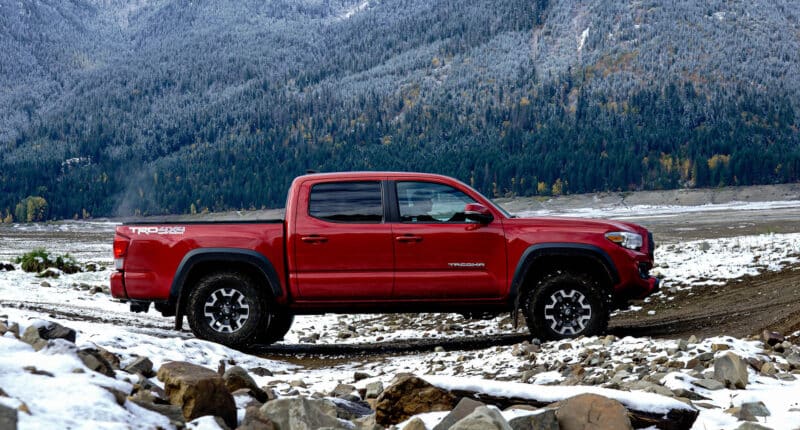

1 comment
Toyota sucks in my opinion had the worst ever experienced by a 2019 Toyota Tacoma from Carlsbad Toyota the warranty they wouldn’t take or honor when things went got broke or failed or needed repair it’s been a nightmare with the plastic on the body itself bumpers are supposed to be to protect it and all they are is plastic cheap cutting corners disappointment 100% too small cab just not satisfied not happy at all.